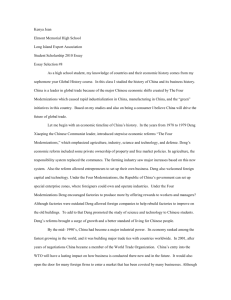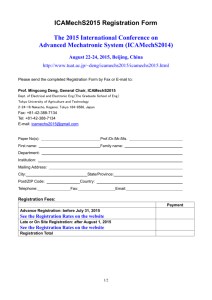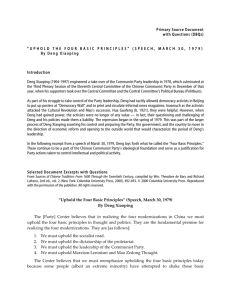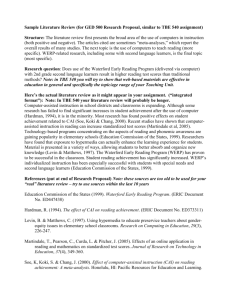Contemporary Memo
advertisement
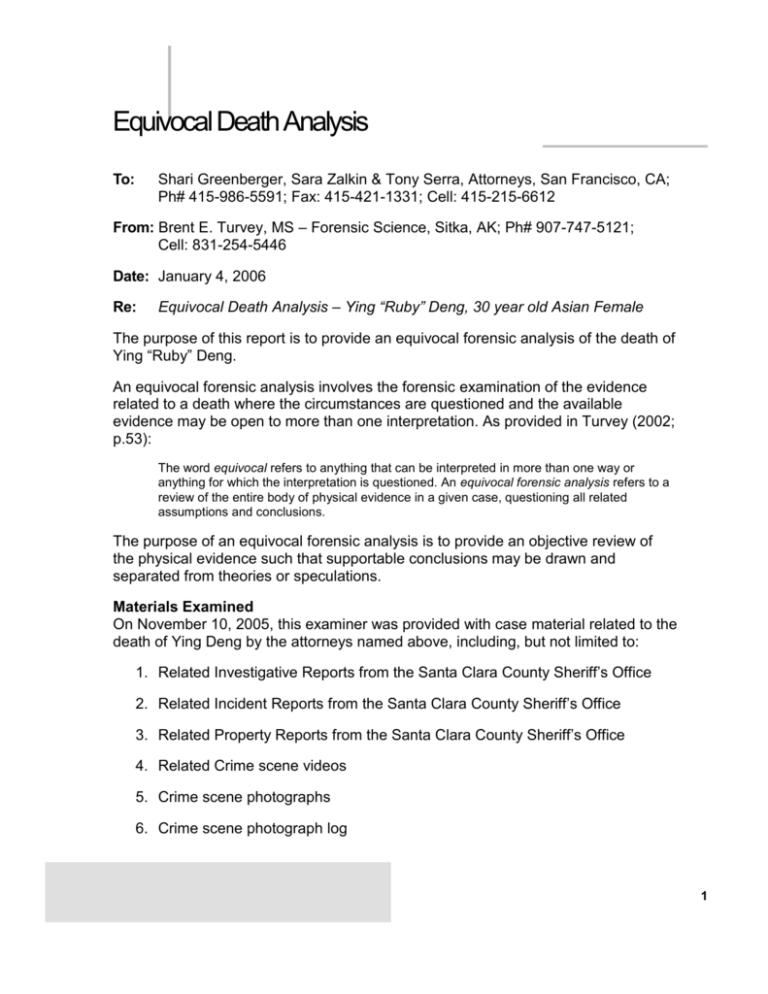
Equivocal Death Analysis To: Shari Greenberger, Sara Zalkin & Tony Serra, Attorneys, San Francisco, CA; Ph# 415-986-5591; Fax: 415-421-1331; Cell: 415-215-6612 From: Brent E. Turvey, MS – Forensic Science, Sitka, AK; Ph# 907-747-5121; Cell: 831-254-5446 Date: January 4, 2006 Re: Equivocal Death Analysis – Ying “Ruby” Deng, 30 year old Asian Female The purpose of this report is to provide an equivocal forensic analysis of the death of Ying “Ruby” Deng. An equivocal forensic analysis involves the forensic examination of the evidence related to a death where the circumstances are questioned and the available evidence may be open to more than one interpretation. As provided in Turvey (2002; p.53): The word equivocal refers to anything that can be interpreted in more than one way or anything for which the interpretation is questioned. An equivocal forensic analysis refers to a review of the entire body of physical evidence in a given case, questioning all related assumptions and conclusions. The purpose of an equivocal forensic analysis is to provide an objective review of the physical evidence such that supportable conclusions may be drawn and separated from theories or speculations. Materials Examined On November 10, 2005, this examiner was provided with case material related to the death of Ying Deng by the attorneys named above, including, but not limited to: 1. Related Investigative Reports from the Santa Clara County Sheriff’s Office 2. Related Incident Reports from the Santa Clara County Sheriff’s Office 3. Related Property Reports from the Santa Clara County Sheriff’s Office 4. Related Crime scene videos 5. Crime scene photographs 6. Crime scene photograph log 1 California v. Jason Y. Cai 7. Crime scene diagrams 8. Crime scene security log 9. Photographs of Jason Y. Cai unclothed 10. Related transcripts and summaries of various interviews conducted by the Santa Clara County Sheriff’s Office 11. Ying Deng, Report of Autopsy and related worksheets and trauma-grams, County of Santa Clara, Office of the Medical Examiner-Coroner by Greg Schmunk, MD dated July 7, 2003 12. Ying Deng, Report of Scene Investigation, County of Santa Clara, Office of the Medical Examiner-Coroner by Judy Melinek, MD dated November 19, 2003 13. Autopsy photographs 14. Forensic Toxicology Report by Dr. Robert Middleberg, NMS 15. Various Physical Evidence Examination Reports, notes, and diagrams by County of Santa Clara Crime Laboratory, Office of the District Attorney 16. Various Field Services Reports by County of Santa Clara Crime Laboratory, Office of the District Attorney 17. Digital evidence from laptop computer of Ying “Ruby” Deng – screen captures of files, recovered files, directories and cached Internet browser files prepared by Kevin H. Peden of Global CompuSearch with Encase Forensic software. Background The following facts and circumstances are taken from the discovery material provided to this officer by defense counsel listed in the previous section. Other facts and circumstances relevant to this examiner’s conclusions will be delineated later in this report. In 2001, Jason Y. Cai and Ying “Ruby” Deng met in an Internet chatroom and began a relationship. Cai was a 44-year-old software engineer from Cupertino, California who had immigrated to the United States from Shanghai more than 20 years ago. Deng was a 30-year-old nightclub agent/ singer with a history that included an arrest for prostitution and jail time. In May of 2001, Cai visited Deng in China for the first time and took her family on vacation. 2 California v. Jason Y. Cai In June of 2001, Cai made his second trip to China. He and Deng had an engagement ceremony at that time. In April of 2002, Deng quit her $1200 USD/ month job as a nightclub agent/ singer at Cai’s urging. He agreed to support Deng and her family at a cost of $900 USD/ month. Between 2001 and May of 2003, Cai visited Deng in China at least four times. In that time, Cai paid Deng in excess of $90,000 USD, to include money for a condominium in Shanghai, vacations for her and her family, jewelry, and other gifts. After his last visit to China, Cai and Deng arrived together in the United States together on May 10, 2003. She moved into Cai’s Cupertino home, and slept in a separate bedroom. It took Cai considerable time, effort, and expense to obtain the proper visas for Deng to gain legal entry into the United States. Soon after her arrival in the U.S., Deng passed the written California DMV test, and Cai started to teach her how to drive. While Cai drove a Honda Civic, he bought her a Mercedes ML300 and a Rolex watch. On My 18, 2003 Jason Cai and Ying Deng were married at the county building in San Jose. Around June 17th, 2003, Cai reportedly agreed to give Deng at least $17,000 USD to arrange travel for her family to the United States. Sometime before June 22-24, Cai reportedly deposited $9,900 USD in Deng’s bank account to begin this process. Deng was listed with profiles and pictures on Asiafriendfinder.com and other dating websites. She also maintained multiple email accounts under various names. On these sites, she listed herself as a single, available Asian women living in the U.S. The available digital evidence indicates that she was most recently attempting to arrange meetings with various Asian men in the bay area. According to her laptop, on June 25th, 2003, Deng was apparently accessing her Asiafriendfinder.com account, her email, and chatting there with one or more individuals through the early morning and late afternoon. At 8pm, Cai reportedly noticed his wife missing from their home and initiated a search. At 9:19pm, Cai called 9-1-1 to report his wife missing. Deputy Zuniga responded to the Cai residence at that time. Just before 9:47pm, Deputy Zuniga and Cai found Deng’s body floating face down the pool in his backyard. She was wearing at least the following: A yellow and orange patterned single piece dress with purple flowers. White slip, purple bra & underwear – all in correct position. 3 California v. Jason Y. Cai Hair pulled back in a ponytail – purple hair tie or clip in place. Recently painted toenails (burgundy) Manicured and painted fingernails (glitter) White metal necklace with white metal heart shaped pendant Diamond earrings Jade-type pendant bracelet on left wrist Gold anklet Shoes (found in pool) Conclusions After a careful review of all of the facts and information provided, it is the opinion of this examiner that the physical evidence, victimology, and death scene of Ying “Ruby” Deng are not consistent with a homicide. The finding in this case is based on the following: 1. There is no definitive physical evidence to confirm the theory that any altercation or acts of violence occurred in the home of Jason Cai on the night of Ying Deng’s death. Deng could have transferred the small amounts of blood found in the Cai home in the master bedroom by touching objects in the normal course of daily activity. The blood could be present as a consequence of her self-inflicted wounds on June 22, only a few days prior. Or it could be a consequence of her menstrual cycle – she found with a feminine pad in place. Notably, the most visible blood is diluted (blood on North end of M/B wall), and certainly not consistent with blood spatter from violent injury. There are no injuries to Jason Cai that are consistent with being in a physical altercation or with physically drowning someone. No bloody or wet clothes, no broken fingers, no scrapes, no scratches, and no transfer evidence from the victim associated with an act of violence. None of Deng’s clothing is torn, damaged or out of place in such a manner as to suggest a physical altercation (her shoes are found in the pool, and could have come off after she drowned in the pool). 4 California v. Jason Y. Cai None of Deng’s jewelry is broken or torn from her body in such a manner as to suggest a physical altercation (the bracelet on her left wrist shows rough abrading, consistent with the directional abrasion she received there). Unlike depictions in film and television, accidental drowning is a quiet event that involves little if any splashing or yelling for help. Moreover, it can happen in less than a few minutes. This would consistent with witness accounts from neighbors in this case. There is no history or allegations of domestic violence with respect to Jason Cai. No domestic violence calls have been reported to the Cai home. There is no evidence Deng complained to her family that Cai was physically abusing her. The only record of violence in the Cai home involves Deng injuring herself. This conclusion is strongly supported by the Medical Examiner’s findings that the cause of death in the case of Ying Deng is fresh water drowning, and the manner of death is undetermined. 2. There is no definitive physical evidence that acts of violence were perpetrated against Ying Deng on the night of her death. According to the autopsy report, an unspecified number of the injuries to Ying Deng were in the process of healing and consequently not associated with her death. There is no documentation of any attempt to reconstruct which injuries must be exclusively associated with her death. There is no documentation of any attempt to reconstruct the directional pattern abrasions and potentially related injuries to determine their precise nature and origin. No evidence exists that supports the conclusion that any of the injuries sustained by Deng must be the result of a physical assault. 5 California v. Jason Y. Cai No evidence exists to refute the theory that some of Deng’s injuries were intentionally self-inflicted. This conclusion is strongly supported by the Medical Examiner’s findings that the cause of death in the case of Ying Deng is fresh water drowning, and the manner of death is undetermined. 3. The physical injuries sustained by the decedent in this case known to be unequivocally associated with the night of her death were primarily in the form of blunt trauma to the head and directional pattern abrasions consistent with slipping, tripping, and falling on or against the objects and surfaces in the pool area where her body was discovered. The blunt trauma injury to the decedent’s head is consistent with falling forward and hitting one’s head on the concrete outside, or the bottom of the pool. There has been no attempt to eliminate this as a possible source of injury. Many of the directional pattern abrasions and contusions to the decedent’s right and left shins, knees, arms, hands, and elbows are consistent with injuries sustain by someone slipping, tripping, falling, and putting their arms up to protect their torso and/ or head. There has been no attempt to eliminate this scenario as a possible source of injury. Catching the edge of the diving board or the edge of the pool during an accidental fall could have caused the fracture to the decedent’s left second rib. There has been no attempt to eliminate this scenario as a possible source of injury. The deeper directional abrasions to the decedent’s knee area are at approximately the same height as the diving board in the backyard. There has been no attempt to eliminate this object as a possible source of injury. This conclusion is strongly supported by the Medical Examiner’s findings that the cause of death in the case of Ying Deng is fresh water drowning, and the manner of death is undetermined. 6 California v. Jason Y. Cai 4. None of the physical injuries sustained by the decedent in this case are consistent with intimacy or overkill, and are consequently inconsistent with injuries associated with an anger-retaliatory motivation. According to Turvey (2002; p. 307) motives are the “emotional, psychological, and material needs that impel and are satisfied by behavior.” Overkill is a term that is used to describe excessive trauma or injury, inflicted beyond that which is necessary to cause death (Burgess et al., 1992, p. 354). It is often evidence of intense personally directed anger or rage. There is no evidence of overkill related injuries in this case. Injuries that require close, sustained proximity with a victim to inflict are also often evidence of personally directed anger or rage. These include injuries associated with manual strangulation, ligature strangulation, and beating, stabbing, or bludgeoning injuries to the face. There is no evidence of such injury in this case. This conclusion is strongly supported by the Medical Examiner’s findings that the cause of death in the case of Ying Deng is fresh water drowning, and the manner of death is undetermined. 5. The victimology in this case evidences a decedent who married for material and financial gain, in which her husband had made financial commitment in order to secure both a marriage and father an heir. 6. The victimology in the case evidences a decedent with a history of prostitution, who was at the very least actively seeking a relationship beyond her relationship with Jason Cai. She was also prone to violent anger and selfabuse. These to the point of extreme suicidal gestures, some of which were recent. These circumstances combine to increases the possibility that her death could have been the result of misadventure. Please do not hesitate to contact me with any questions. ____________________ Brent Turvey, MS CONFIDENTIAL 7 California v. Jason Y. Cai References Burgess, A., Burgess, A., Douglas, J., and Ressler, R. (1992) Crime Classification Manual, New York: Lexington Books. Turvey, B. (2002) Criminal Profiling: An Introduction to Behavioral Evidence Analysis, 2nd Ed., San Diego: Elsevier Science 8
